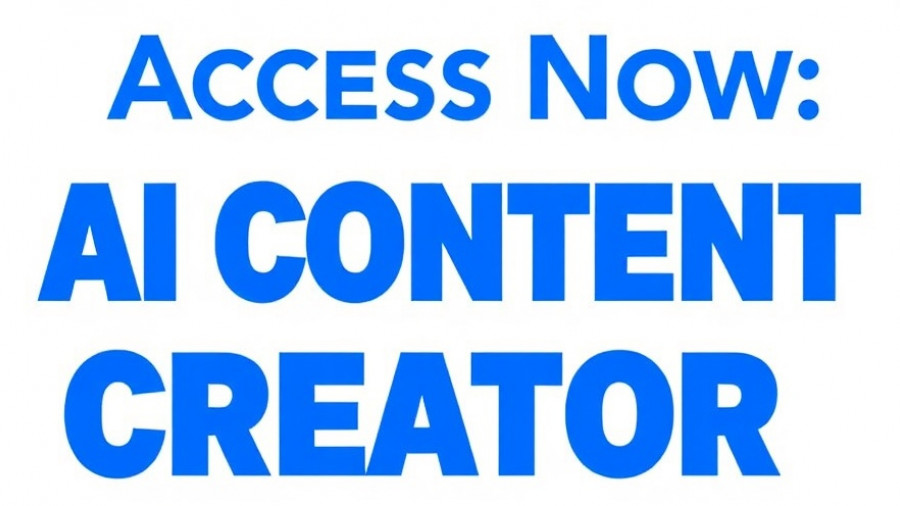
The Evolution of Creator Marketing in Today's Digital Landscape
In a world where marketing continues to evolve, the concept of creator marketing stands out as a transformative approach that every business can leverage. As Lindsey Gamble succinctly puts it, 'In today's day and age, everyone is a creator.' This statement reflects the shifting dynamic where traditional boundaries are blurred, allowing even small businesses to tap into a vast pool of potential creators, regardless of their follower count.
For example, a local restaurant can collaborate with a foodie who may only have hundreds of followers yet possesses the power to influence their community authentically. This authenticity breeds trust, a vital element for customer conversion, as smaller creators often have closer, more engaged audiences.
Why Authenticity is Key in Creator Marketing
The power of creator marketing lies in its authenticity. Unlike conventional marketing methods, where brands control the narrative, creator marketing embraces a more natural flow of information. People tend to trust recommendations from creators who genuinely believe in the product or service they are promoting, making it essential for businesses to choose collaborators wisely.
Influencer marketing thrives on social proof—the credibility gained from the voices of others. Brands should aim to cultivate long-term relationships with creators who align closely with their values. This approach fosters an ongoing dialogue between the brand and audience, enhancing the audience's connection to the product. Treating creators as partners rather than mere channels to amplify messages can result in innovative, compelling content that better resonates with their communities.
Case Studies: Success Stories from Diverse Industries
There are countless examples of businesses that have flourished by leveraging creator marketing. Consider a sleep apnea device company that collaborated with a niche influencer in the health sector. They witnessed double-digit growth simply through targeted engagement with a highly specific audience. This successful partnership highlights how effective creator marketing can be, even in industries regarded as 'boring' or highly specialized.
Another illustrative case involves a fashion brand that partnered with micro-influencers on TikTok. By allowing these creators to communicate in their own voice, the brand saw a significant uptick in both engagement and sales from a younger demographic that traditional advertising methods had failed to reach effectively.
Actionable Insights: Building Your Creator Marketing Strategy
For businesses considering entering the realm of creator marketing, several actionable insights can help create an effective strategy:
- Identify Your Audience: Understand who you're trying to reach and what their interests are. This will help you select creators whose audiences align with your target market.
- Set Clear Goals: Are you looking to raise awareness, drive traffic, or boost conversions? Different creators and strategies work for different objectives.
- Collaborate Creatively: Instead of chasing after creators with millions of followers, focus on those who resonate with your brand ethos. Collaborate on innovative content that captures the essence of your brand while allowing the creator to express their unique voice.
Future Predictions: The Expanding Role of Creators
As technology continues to advance, the role of creators is expected to grow even more. With more tools at their disposal, creators will be able to craft personalized experiences that can closely mirror the desires of their audience. Consider the rise of platforms like TikTok, which has democratized content creation and provided a unique outlet for brands to connect personally with consumers.
In the coming years, expect to see businesses employing data-driven insights to guide their creator collaborations, ensuring that their efforts are tailored to maximize engagement and conversions. As marketing automation advancements integrate with creator marketing, we may also witness enhanced methods for measuring ROI from these partnerships.
Concluding Thoughts on the Value of Creator Marketing
As the lines between creators and consumers continue to blur, businesses must adapt to a new marketing paradigm that prioritizes authenticity, community, and trust. By embracing the fact that anyone can be a creator, brands can tap into rich networks of potential customers who value peer recommendations over traditional advertising. The future of marketing lies in collaboration, innovation, and the genuine connections formed through creator partnerships. To succeed, businesses must diversify their approaches, leveraging the power of creators in ways that are meaningful and impactful.
Ultimately, whether you're a digital marketer, agency, or small business looking to enhance client acquisition, embracing creator marketing can open doors to new audiences and opportunities. By harnessing the diverse voices within the creator economy, you can engage your customers more authentically, fueling growth in today's competitive landscape.
 Add Row
Add Row  Add
Add 




Write A Comment